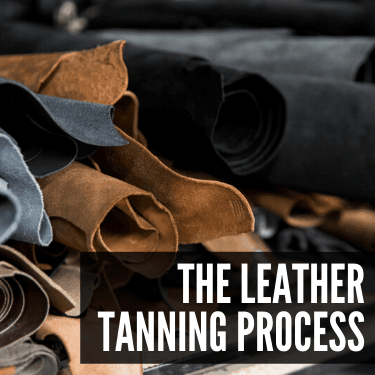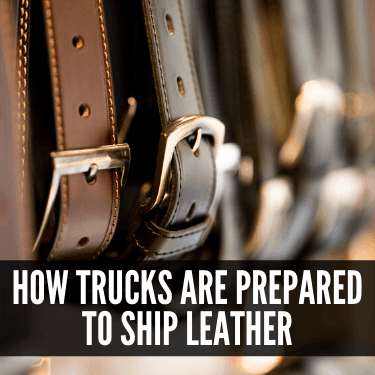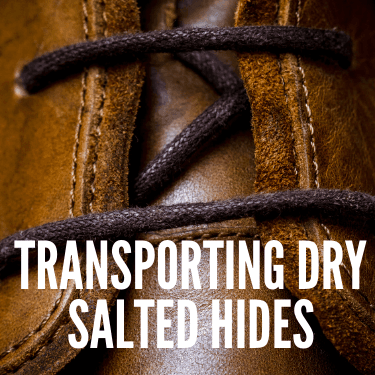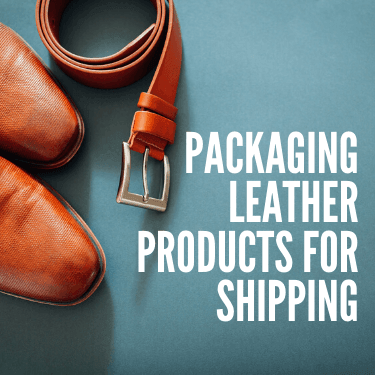Whether it’s a pair of shoes, a saddle or any of the other many items made, the leather industry is worth billions of dollars in the United States alone. With so much money at stake for what is hard work, you’ll need to solve the equation of how to transport leather — either for the first time or more efficiently so you can realize more profits from effort.
Luckily, this article has got you covered. We will walk you through the leather-making process and also the various facets of how to transport leather. So let us put on our leather driving gloves and slide into the leather driver’s seat to take you through everything that comprises this field.

The process of tanning hides into leather has existed for millenia. From its less advanced method of turning animal skin into its final form using viscera from other creatures or even urine, the process has evolved greatly into the present day and isn’t quite as gory anymore.
To a more recent extent, the first leather tanner in what is now the United States opened in 1616 in Jamestown, Va. So the industry in the country actually predates the country.
Almost any animal’s skin can be formed into leather. Some of the most popular forms come from:
In the United States, the majority of leathers produced are made from the skins of cattle or sheep and is considered a by-product of the meat industry. In 2017 alone, America exported a shade over $2 billion in leather products, so knowing the process of how leather is made is an important aspect of how to get a piece of that pie.
The way leather is made boils down to a specific set of steps that take a raw product and convert it into a material used for clothing and fashion accessories
The animal, most likely a cow but it can be any living creature, is slaughtered and then skinned while it is still warm.
The skin is then cured using salt. The salt is applied to stop the growth of bacteria and to reduce moisture in the hide.
After the skin goes through its salt preparation, clean water is then used to bring moisture back to the skin and remove any salt still present from the curing process.
Once soaking has commenced, liming occurs by treating the hide with milk of lime (also known as lime water or a watery solution of calcium hydroxide). Milk of lime is used in conjunction with sodium sulfide, one example of a sharpening agent that could also include cyanides or amines.
What this does is removes hair, grease and proteins while swelling up and splitting the skin fibers to the level needed. During liming, the collagen is brought to the condition desired to achieve proper tanning.
As an alternative to liming or to supplement it, unhairing uses further chemical agents to make the hair easier to remove. After the chemicals are applied, most of the hair is removed using a machine then a knife with a dull blade, which is known as scudding.
The next step makes sure the pH level of the collagen, the most abundant protein in the body, is lowered so enzymes can act upon them. This can also make the leather more supple if certain enzymes are introduced. In earlier times, this part of the transformation was done using dung water to instigate fermentation by bacteria.
Once deliming and bating are completed, the skins are treated with common salt followed by sulfuric acid. What this does is further lowers the pH level of collagen so that the agents can penetrate the skin.
The process of tanning is where the animal hides and skins finally become leather. If a skin were not tanned, it would harden and decompose. So this is the big step that needs to occur to also make sure that the leather is either thick and durable or thinner and more supple depending on what it will eventually be used to make.
While the end result is roughly the same, there are a few different ways hides are tanned:
This method of tanning is much faster than vegetable tanning, but also a lot less natural. In fact, if the process is not carefully undertaken, it could have a negative environmental effect. However, chromium tanned leather tends to be softer and also less likely to be water stained.
So an animal skin is placed in a tanning solution and soaked. There are a few potential drawbacks to using vegetable tanning. The first is the long time it takes, which could be up to two months since the water needs to be fully extracted with this method over a longer period of time than mineral tanning. Also, it takes a lot of time and effort from craftsmen to pull this off.
Also leather made from this process won’t be as soft and it is more susceptible to water stains.
There are a few other differences between chrome and vegetable tanning that should be considered. Chrome tanned leather is more heat resistant than its vegetable tanned counterpart, so it is less likely to crack or dry out. Yet if vegetable tanned leather is properly cared for, it can possibly last hundreds of years. Mineral tanning allows the leather to be dyed in a wide variety of colors while mineral tanning tends to be more earthy colors.

With the organic nature of leather, there does have to be some level of care taken to protect it during shipping. But it’s also worth discussing how to protect your truck if you’re shipping huge loads of leather — especially of the wet variety. You’ll need liners like plastic or vinyl in order for easier cleanup jobs after transporting these (which you can read more about in the next section).
Leather is fairly heat and cold resistant, except for extremes at either end, so shipping them on a regular freight load should suffice. However, if you are personally concerned with keeping the products in a certain temperature and humidity range, it could be worth it to ask for a climate-controlled truck. While it might cost a bit more, you’ll be assured that your leather products will show up at the retailers in their best condition.
Other than those provisions, dry, cured leather isn’t very much different than any regular load you’d ship. Fire extinguishers aren’t required like they’d be with untreated animal hair or skin. There are specialized cases, though, which you can read on for specific examples.
This is where things can get messy. When transporting wet salted hides, you have to account for a natural biological process that occurs which can create a liquidy run-off. These hides are placed on pallets and “shed” the salty brine solution they were cured in prior to shipping.
In many cases, these hides are wet, smell badly and still have hair or wool attached to them, along with fat or blood. Understandably, this attracts bacteria growth and many insects, both of which feed on the source.
So when transporting hides, the inside of the freight hauler should be lined in order to catch the briny excretion. This will definitely minimize the cleanup afterward and hopefully cut down on the smell of decay. For this reason, these deliveries should also be done quickly since the longer wet salted hides are in the back of the truck, the more they will purge themselves of the solution.
One more note about the liner: it should be tub-shaped if possible, line every surface and be thick so that the salty solution is well contained.
While it might not be feasible to use a climate-controlled truck for a job like this, the temperature should also not be stuffed in the back of a hot truck because it will only accelerate this brine sweat and accelerate the degradation of the product.
While these have the word “wet” in the name, these are not the same as wet salted hides. These have already been heavily cleaned and don’t have any fat, hair or collagen in them. Also like the name suggests, the chemical processes wet blue hides have undergone do leave the hides blue tinted.
The wet blue hides also have whatever water or moisture is left over chemically bonded to the collagen proteins, so they are not outwardly wet like the salted ones are. So these hides are usually palletized and can be stacked or unstacked.
For further protection, they can be wrapped in plastic on the skid and also strapped down to the pallet as well to help them reach their destination unharmed.

Of the three different kinds of hides discussed, this has the least amount of special car needed to ship. Prior to shipping, these hides have all their salts extracted and are air dried. This ensures that there is no water or moisture present in the hides themselves.
The only real preparation that needs to be taken to transport dry salted hides is against humidity. So something like cardboard, fine grade absorbent sawdust or protective liners can be put down to soak up or catch any moisture that could occur.
Unfinished leather hasn’t gone through the final stages of treatment that finished leather has, which makes it very absorbent and also more fragile than treated leather. Some people prefer the unfinished version better, though, because it is softer than its finished counterpart, warmer to the touch and also has a richer color.
Finished leather receives a chemical treatment so that it is more resistant to wear and tear and also less likely to be stained or otherwise ruined by liquids. In this comparison, it stands to reason that extra precautions have to be taken to ensure that unfinished leather products don’t pick up undesirable defects.
So one of the biggest things that can be done to that end is to make sure the temperature is well regulated. The leather will theoretically be packed in sealed containers, so keeping it at an optimal temperature of about 68 degrees fahrenheit is recommended. This should be coupled with the relative humidity of no higher than 65 percent, although as outlined earlier, 30 to 40 percent is the sweet spot for leather.
The humidity level is important from the perspective that if the leather products are sealed in plastic, a rise in temperature to more than 100 degrees fahrenheit in the back of an 18-wheeler without climate control — which would not be hard to hit on a hot summer day — would cause humidity to rise inside the bagged leather and promote mold growth.
Luckily, leather is not very flammable so it shouldn’t go up in a huge blaze if a fire broke out. That’s not to say it is impossible, but that shouldn’t be a large factor in your shipping plans.
On the other hand though, you want to keep leather away from water. This is easily enough done by shipping it in an enclosed tractor trailer that is water tight with no leaks or big gaps where rain can get in.
This is important not only for the leather to be ruined or stained but to inhibit the growth of mold, which can grow in hot, humid conditions or when water is present. Also, vegetable tanned leather is more susceptible to mold growth than chrome tanned leather which is something to keep in mind. Beetles can also be a concern as well with raw hides being shipped, so those should be dusted with insecticides if you think that could be a possibility.

Shipping leather products definitely needs to be done with care. Leather-made goods are time-intensive to make (as previously discussed) and of a much higher average value than products made of other materials.
So the two biggest things you need to be concentrating on when shipping leather is to make sure it doesn’t get scratched or affected by the elements. So leather should be packaged in protective material like cardboard boxes and possibly even wrapped in plastic bags to really give it an added layer of protection against scratches.
As far as the elements go, leather is best kept in a range of 30 to 40 percent of relative humidity. Below 30 percent, it can dry out and crack and above 40, it can absorb too much moisture from the air and start causing it to rot. While rot won’t set in immediately, constant exposure to higher humidity can cause damage within days. For this reason, silica gel is often added as a desiccant — a substance that helps keep a state of dryness in its proximity — to combat humidity during the transport of your leather products.
In fact, silica gel is so effective in this capacity that one recommendation for keeping leather shoes at their best is to keep silica gel packets in them to absorb moisture that inevitably builds up in daily use.
Now that you have a greater understanding of how to transport leather, entrust your shipment to the experts at R+L Global Logistics. We have years of experience handling large loads and can make sure to get your finished product to retailers without a hitch.
Something we pride ourselves on at R+L Global Logistics is our ability to transport freight in a timely manner. To this end, we sport a 99.5 percent on-time delivery rate, which means 199 out of every 200 loads we carry will reach its final destination either early or on time. We also take our relationships with our customers very seriously and deliver industry-leading customer service to that end.
USA Truckload Shipping, powered by R+L Global Logistics, can help move almost any commodity. From transporting leather to shipping bulk cattle feed, we're here to assist.
If you have a question or concern about your shipment at any time, you can reach out to us. We also have additional resources available to answer your questions about freight shipping.
R+L Global Logistics also offers additional services that can add value to your business. For instance, expedited shipping is available for an additional cost but can also cut down your shipping times by up to two days depending on the distance. Also, if your leather products are not quite ready to go to the final point yet, we also offer warehousing solutions to store your leather.
So when you know how to transport leather and are finally ready, contact the trusted, experienced team at R+L Global Logistics to find out how we can help you. For a free quote today, call us at 866.353.7178.
R+L Global Logistics
315 NE 14th St., Ocala, FL 34470